Vegetable stir-fry is a quick and easy Chinese dish. However, if you do it right, sir-frying only adds a new dimension to your plain vegetables.
I want to explain how to prepare Chinese vegetable stir fry in this article. Your gorgeous vegetable stir fry with remarkable texture will knock your socks off. You will immediately recognize the ineffable taste that you are familiar with at the Chinese restaurant.
This step-by-step guide will show you all the nitty-gritty of preparing Chinese vegetable stir fry and deal with the fundamentals that go into Chinese vegetable stir fry. Chinese stir fry vegetables were my favorite recipe when I worked in the restaurant. It is a great side dish we recommend when someone orders meat dishes as the main course.

Note: This post may contain affiliate links. Please read my privacy policy for more info. I may receive commissions for purchases made through links in this post. As an Amazon Associate, I earn from qualifying purchases.
Chinese vegetable stir fry- How to prepare in five simple steps
I have divided this recipe into five steps:
Step 1: Prepping the vegetable
Step 2: Blanching the vegetables
Step 3: Prepping the sauce
Step 4: Saute the fresh garlic
Step 5: Stir-fry the vegetables
Step 1: Prepping the vegetables for stir-frying
The first step is to blanch the vegetables. In this recipe, I am using five common vegetables to prepare the stir-fry- broccoli, cauliflower, capsicum (bell pepper), snow peas, and carrots. Here are the details on how to prepare each of these vegetables.
Broccoli. Cut the stem close to the head so the florets will detach naturally. Discard the lower part of the stem, which is usually hard and fibrous. Cut the more tender part of the stem into slices or wedges. This section is full of flavor, so I suggest you not throw them away.
Cauliflower. Cut the cauliflower half from the crown’s top through the stem. The large florets will naturally fall off from the core. You can use the tip of the knife to separate the large floret into bite-size. I prefer to have large florets as it looks better
Take a look at the surface of the cauliflower. If it develops some small black specks on the surface, remove them by using a vegetable peeler before cutting. It is easier to remove the black specs before cutting than after.
Snow peas (or snap peas). Remove the ‘string’ of the snow peas that is tough and fibrous. To do this, pinch the curly end of the snow pea, and pull it along the pod to the other end until it separates from the snow pea.
Carrots. Peel off the skin of the carrots. Cut the carrots into wedges at an angle and turn them a quarter after each cut.
Capsicum (bell peppers). Cut the top and bottom away. Then you can remove the core and seeds quickly as it is still intact as one piece. Cut the capsicum into large slices of triangular shape. I prefer mixing green and red peppers to make them more colorful.
Note: The choice of fresh vegetables for Chinese stir fry is versatile. Water chestnuts, green beans, and baby corn are some common ingredients you can add to this recipe.
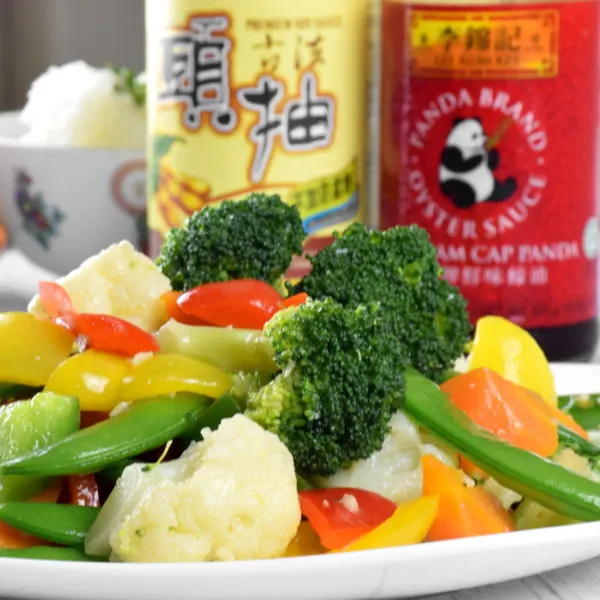
Step 2: Blanching and shocking the vegetables
a. Blanching
Blanching the vegetables before stir-frying serves two purposes:-
- Shorten the time required for stir-frying. Since stir-frying is quick, the time involved is insufficient to cook through some vegetables, such as a wedge of carrot. Blanching is even more relevant when you want to ensure the bigger florets of cauliflowers and broccoli are cooked. Furthermore, prolonged frying will cause the vegetables to become yellowish and lose their bright color. I regularly blanch them and only stir-fry the vegetables over high heat briefly.
- Set aside for later use. This method will deactivate the enzymes, which will discolor foods and cause them to deteriorate. By doing this, the color will maintain even after a few hours. You can also get this done a day before and store them in the refrigerator until the following day.
Here are the steps:
- Brings a pot of water to a boil. The amount of water should be at least three times the volume of the vegetables.
- When the water is boiled, place the carrot wedges into the water. Let them cook for three minutes.
- Once the carrot pieces are half cooked, add cauliflower and broccoli florets into the water. Keep the water at a consistent boil for two minutes.
- Add the snow peas and boil for one minute. Use a fork to pierce into one of the broccoli florets. The broccoli and cauliflowers are done when the fork can slide in and out smoothly. The snow peas should be crisp and cooked by now.
- Lastly, add the capsicums and let them heat up in the water for fifteen seconds.
- Drain with a wire mesh strainer or colander. Set aside for stir-frying.
b. Shock the vegetables with ice water
Shocking means putting the vegetables into an ice bath to halt the cooking process immediately. This method stops the vegetables from cooking from the inside, which results in a mushy and discolored product.
Shock the vegetables if you intend to keep them for later use. Otherwise, you may head straight to stir-frying after blanching.
Here are the steps:
- Prepare an ice bath (cold water with ice cubes).
- Drain the vegetables after blanching. Pour the vegetables into the ice bath immediately. Make a few stirs to let the heat dissipate from the vegetables.
- Let the vegetables cool down for a few minutes in the ice bath to cool the inner part completely.
- Drain and store in the refrigerator.
Note: Are you concerned blanching will destroy the nutrition?
This is a method we use in restaurants. It is convenient, quick, easy, and suitable for preparing a large batch of vegetables for stir-frying.
However, this method can destroy part of the vitamins and nutrients. If you are concerned about this issue, steaming the vegetables for about 6 minutes is the best alternative to this method.
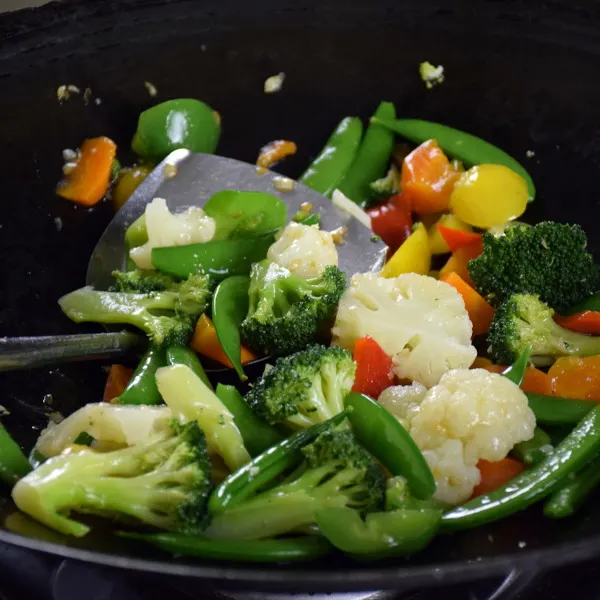
Step 3: Prepping a simple sauce
Prepping this delicious stir fry sauce is simple. I recommend the following basic stir-fry sauce for this recipe. I don’t believe there is a definite best stir-fry sauce. You can make changes by adding soy sauce and sesame oil or changing the amount of each ingredient according to your preference. This savory sauce is also suitable for stir-frying meat and seafood dishes.
a. The formula of stir-fry sauce
2 teaspoons of salt
1.5 teaspoons of sugar
2 tablespoons of oyster sauce
1/2 teaspoon of cornflour
A dash (about 1/8 teaspoon) of ground white pepper
4 tablespoons of water
Noted that I have included cornflour as one of the sauce ingredients. Therefore, you no longer need to add ‘cornflour slurry’ during stir-frying.
There is no time to waste during busy hours in the restaurant. Hence, we make a large batch of this sauce and store it in the refrigerator. By making it in advance, you can adopt the same concept if you want to prepare a significant portion for your guests for parties. Otherwise, mix all the ingredients in a small bowl before stir-frying to avoid miscalculating or unintentionally leaving out any ingredients.
b. How do you stir-fry leafy vegetables like bok choy and choy sum?
You do not need to blanch leafy vegetables like bok choy, Chinese broccoli, or choy sum. They are thin and can cook through easily.
Cut the stem of the bok choy and choy sum into thin slices. Stir-fry the vegetables with garlic and fresh ginger for a minute, then add a little water to cook the stems until they turn soft. Once the stem becomes soft (you can pick one a tray), add the leaves and continue cooking until the leaves wilt.
Stir-fry choy sum or bok choy is the most common home-cooked dish for the Chinese. Simple, quick, and delicious, all you need is just oil, garlic, salt, and vegetables. You can refer to this recipe for more details.
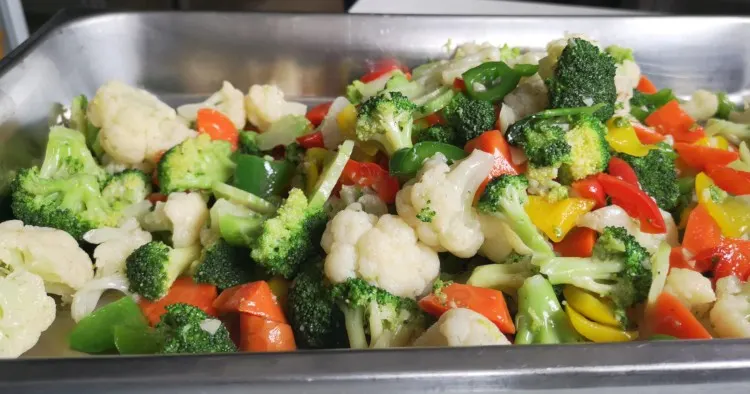
Step 4: Stir-frying the vegetables
You may have watched the Chinese restaurant chef stir-fry over a towering inferno, but in practice, this seems a distant dream to come through in the home kitchen.
I would very much suggest you purchase a high power wok burner. It is not expensive and is invaluable for stir-frying. If this is impossible, you can still produce an excellent dish by following these steps.
- Heat some vegetable oil in the wok (or saucepan).
- Add a tablespoon of chopped garlic and saute over low heat until it turns aromatic. Here you have two choices. First, stop short once the garlic becomes fragrant or continue sauteing it until it turns golden brown (and crispy). Secondly, If you want the garlic crispy, continue to stir and move the garlic around, or else it will tend to stick to the wok and burn quickly.
- Add the pre-mixed stir-fry sauce and continue the cooking process. The cornstarch is cooked when the sauce turns translucent. You should take note of this, as uncooked cornstarch tastes awful.
- After that, add all the drained vegetables to the wok.
There are two ways to stir fry
- If you want to serve the Chinese vegetable immediately, crank up the heat and stir-fry over the highest flame you can muster. Stir fry for a short moment (around half a minute) until you can smell the familiar aroma of the Chinese restaurant. We called it wok-hei, or ‘the breath of the wok.’
- If you plan for a party where you want the vegetables to stay fresh, just mix the vegetables with the sauce in the wok. You can leave the flame on, but it is over low heat. Once the vegetables are coated with the delicious and glossy sauce, remove them from the stove to prevent overheating. The garlic will provide a delightful flavor minus the signature aroma of wok-hei. When preparing it for a large party or buffet, I expect the guests to eat much later. The vegetables will turn yellowish and lose the bright, fresh look.
Dish out. Chinese vegetable stir fry is best served with white rice, noodles, or just from the wok. You may garnish it with some sesame seeds and green onion rings.
Cook’s note:
- The stir fry veggies are among my favorite dishes that I used to serve in my previous restaurant. They perfectly accompany various meat dishes and can be enjoyed with either white or brown rice. While we used a large wok for cooking in the restaurant, you can achieve equally good results at home using a large skillet (if you don’t have a wok available).
- This stir-fry is a great way to utilize the vegetables in your refrigerator and a flexible recipe for adding other veggies using the same cooking method. For instance, leafy greens and green onions make great options to consider. However, I strongly recommend using fresh veggies instead of frozen ones, as they make a noticeable flavor difference.
- If you have any leftovers after making this easy vegetable stir fry, keep it in an airtight container which allows it to stay fresh for a day or two in the fridge. I would not suggest you freeze it, as it will not turn out well.
- Add proteins, such as chicken breast meat, to stir-fry with these vegetables to make it a complete meal.
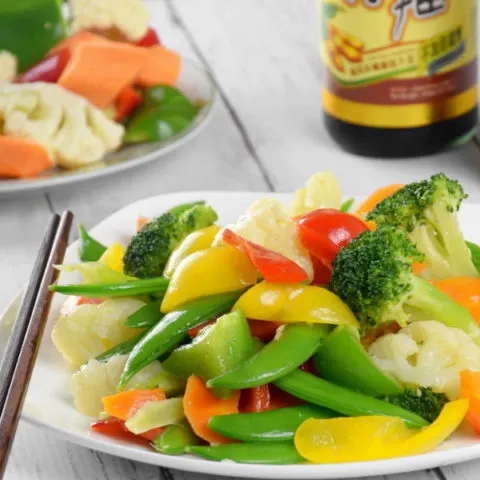
Chinese Vegetable Stir Fry
Chinese vegetable stir fry is a quick, easy and delicious recipe. Take only 20 minutes to prepare, Best to serve with rice, noodles or just eat straight from the wok!
Ingredients
Ingredients A (vegetables)
- 100 g broccoli
- 100 g cauliflower
- 100 g carrot
- 100 g snow peas
- 100 g capsicums
Ingredients B (Seasonings)
- 1 teaspoon salt
- 3/4 teaspoon sugar
- Dash ground white pepper
- 1 tablespoon oyster sauce
- 1/4 teaspoon cornflour
- 2 tablespoons water
- 1 tablespoon chopped garlic
- 1 tablespoons vegetable oil
Instructions
Prepping the vegetables
- Cut the broccoli and cauliflower into florets.
- Peel and cut the carrots into wedges.
- Remove the stings of the snow peas.
- Cut the capsicums into triangular pieces
- Blanch the vegetables. Drained and set aside.
Stir-frying
- Heat up the vegetable oil in the wok.
- Saute the garlic until fragrant over low heat.
- Add the salt, sugar, ground white pepper, oyster sauce, cornflour and water. Cook until the sauce becomes translucent.
- Add the blanched vegetables. Stir-fried over high heat until it turns fragrant.
- Dish out and serve.
Recommended Products
As an Amazon Associate and member of other affiliate programs, I earn from qualifying purchases.
Nutrition Information:
Yield: 2 Serving Size: 1Amount Per Serving: Calories: 165Total Fat: 8gSaturated Fat: 1gTrans Fat: 0gUnsaturated Fat: 6gCholesterol: 0mgSodium: 1367mgCarbohydrates: 22gFiber: 7gSugar: 10gProtein: 6g
This data was provided and calculated by Nutritionix on 1/26/2019



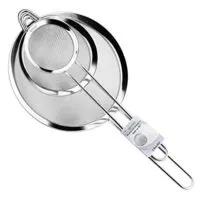
Zucchini stir fry with chicken - How to prepare easy Chinese takeout
Friday 23rd of May 2025
[…] craving Chinese takeout.Stir-fry adds a whole new dimension to your plain vegetables. Try this vegetable stir fry with broccoli, cauliflowers, carrot, and snow peas.Bok choy stir fry might be downright simple, but […]
How to Blanch Vegetables Before Cooking
Saturday 8th of February 2025
[…] might wonder why we should blanch vegetables instead of grilling or stir-frying them immediately to save time. While it’s certainly possible to skip blanching, there are […]
Ken
Wednesday 26th of April 2023
Video blacks out after a few minutes.
KP Kwan
Thursday 27th of April 2023
I tested it, and it has no problem. Not sure why it happened on your end. The quick fix is to watch it on my youtube channel. (the same video). https://youtu.be/k3_rRmeDJW0
Tasmiah Amin
Thursday 13th of January 2022
Hi, I find out perfect recipe for me and my family. I want ask you one question , After branching vegetables can I use the Vegetable water as stock , I mean can I make soup with it. Please let me know. Stay well. God bless you.
KP Kwan
Saturday 15th of January 2022
I usually throw away the water, as I use quite a bit of water, and it does not taste great.
Rhonda Smith
Wednesday 8th of December 2021
Thank you for such a friendly step by step video!! I always make a messy mush of stir fry!
China Chef
Sunday 2nd of October 2022
@Rhonda Smith, If you're the R Smith with the Amazon review believing you can get Wok Hei from a $200 induction Wok it's no wonder your stir fry are a messy mush.